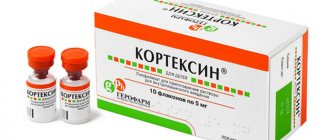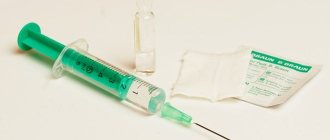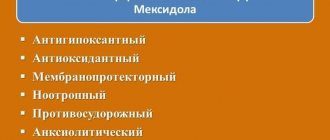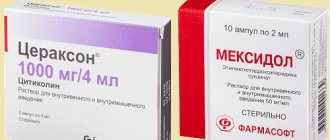Mexidol for VSD - dosage, injections, reviews
Experts continue to study the characteristics of vegetative-vascular dystonia and the options for therapy used.
To date, the only correct method of treatment has not been determined. Scientists have developed several types of therapy used. One of the proposed ways to cure VSD is the use of Mexidol. This is a new generation antioxidant that is currently very popular.
Mexidol for VSD copes with unpleasant symptoms quickly and effectively.
Description of the disease
Vegetative-vascular dystonia is a complex of various symptoms that cause pain to a person. When such a disease occurs, the following pathologies are likely to occur:
- disruptions in the functioning of the endocrine system;
- mental disorders;
- insomnia;
- neurosis;
- migraine due to vasoconstriction;
- depression;
- heart failure, including the occurrence of extrasystole.
Features of VSD treatment
The manifestation of symptoms of VSD can begin in stressful situations and even at a time when nothing portends danger. Symptoms may include: headaches, neurological disorders, weakness of the body as a whole, swelling, and disruptions in the functioning of the respiratory system.
VSD is often accompanied by mental disorders, so experts have focused on treating the disease using an antioxidant drug. Mexidol is considered one of these.
Antioxidants are substances whose effects are due to the protection of cells from oxidative processes occurring in the cells of the human body due to various reasons.
When studying VSD diseases, scientists noted that quite often people experience disturbances in the functioning of the human brain. Scientific research has been carried out.
Based on their results, they came to the conclusion that the use of the drug Mexidol leads to an increase in human labor intensity and eliminates fatigue syndrome in VSD.
This leads to the restoration of the normal functioning of the nervous system during VSD.
The use of Mexidol for VSD should be carried out only as prescribed by the attending physician. If used independently, serious problems may arise.
Description of the drug Mexidol
Determining the exact classification of the drug Mexidol is quite problematic. The fact is that this remedy is capable of providing various therapeutic effects and influencing different systems of the human body.
The drug Mexidol belongs to several pharmacological groups. It can be attributed to medications that have a positive effect on the cardiovascular system in VSD.
Mexidol also refers to medications that act mainly on the cerebral vascular system. At the same time, Mexidol is a type of antioxidant.
There are several options for the effect of Mexidol on the human body. Thanks to the effect of the active substance of the drug, which is ethylmethylhydroxypyridine succinate, there is a positive effect on the manifestation of the following effects:
- antioxidant;
- antihypoxic;
- neuroprotective.
The drug Mexidol is a powerful antioxidant. From which we can conclude that when taken, lipid peroxidation is blocked, as a result of which cell membranes are normalized. The drug Mexidol is able to protect cells of internal organs during VSD. The positive effect of the drug is aimed at protecting liver and brain cells.
The antihypoxic effect is understood as an increase in the body’s ability to be stable at low oxygen levels in the blood as a result of the use of Mexidol. This is very important in the treatment of VSD accompanied by hypoxia. A short-term decrease in the need for oxygen helps to increase the stress resistance of the human body.
The lipid-lowering effect of Mexidol is an excellent prevention of atherosclerosis in VSD. It is noted that this drug to some extent contributes to blood thinning during VSD.
The manifestation of a mild anxiolytic effect of Mexidol contributes to the additional suppression of emerging stress conditions during VSD. Experts note that when Mexidol is taken in combination with tranquilizers, antipsychotics, and antidepressants, an enhanced effect of all drugs for the treatment of VSD is observed.
How to take Mexidol for VSD
There are two main methods of taking the drug: oral administration (tablets) and injection (solution). The most widespread use of Mexidol is oral administration.
This is due to the simplicity of the method for the patient; there is no need for inpatient treatment. Almost always, such treatment for VSD is well accepted by the body. Unfortunately, there are exceptions.
Let's take a closer look at these medication options.
Mexidol tablets for VSD are mainly used to treat mild forms of VSD and for the treatment of children. One Mexidol tablet contains 125 mg of active ingredient.
In practice, doctors use a treatment regimen for VSD, which prescribes taking 1-2 tablets three times a day, depending on the complexity of the disease. There is a limitation in the dosage of Mexidol taken for VSD - a maximum of 800 mg, which is equal to six tablets. The course of treatment for VSD varies from one to three months.
Repeated treatment is possible, but should not be used more than three times a year. Treatment of VSD is recommended in spring or autumn. This is due to the frequent exacerbation of signs of VSD at these times of the year.
Mexidol solution for vegetative vascular dystonia
The use of the substance in ampoules is practiced when establishing a severe form of VSD disease. One Mexidol ampoule contains a five percent solution with a volume of 2 ml.
It is permissible to administer the drug Mexidol both intramuscularly and intravenously. The method of administering the Mexidol injection is determined by the doctor, based on individual characteristics. Most often, patients are prescribed intramuscular injections into the buttock. In extremely severe cases of VSD, droppers with Mexidol are used.
Injections are carried out three times a day, trying to stick to the same time. The course of injection therapy with Mexidol for VSD lasts for 7-10 days. After completing this course, the patient is prescribed further treatment for VSD with Mexidol in tablet form.
Contraindications and side effects
During the use of the drug Mexidol, a small number of side effects for VSD were identified and low toxicity was noted.
There are some restrictions on the use of the drug:
- the presence of renal or hepatic pathology. From the effects of the drug Mexidol, the lining of the liver or organs that are located nearby may become ill due to an increase in size;
- course of pregnancy. The risks of exposure to the drug Mexidol on a woman’s fetus have not been studied;
- lactation;
- children of all ages. The use of Mexidol in pediatrics is prohibited due to the components of the drug that are not intended for children.
Mexidol is contraindicated for people with pronounced intolerance to individual components of the drug. When undergoing a course of treatment for VSD, various effects on the human body may be noted.
Known side effects of the drug Mexidol include:
- nausea. This is not a rare occurrence in VSD. Subsequently, after taking Mexidol, the frequency of its occurrence increases, even if you follow a regimen and a healthy diet;
- vomiting occurs periodically;
- dry mouth;
- there may be a feeling of increased drowsiness, lack of strength while using the drug Mexidol;
- Allergic reactions are rarely observed;
- in case of prolonged use of Mexidol, addiction is likely to occur. And at the end of the next course, there is a feeling of dependence on Mexidol;
- the components of the drug affect concentration and attention, therefore Mexidol is prohibited for people whose professions require serious concentration.
Even despite the low toxicity of the drug, it still has a certain effect on the human body. There are few side effects from this, but if they occur, you should consult your doctor.
Reviews
Before starting to take the prescribed drug, patients have a desire to study it in more detail. Patients are interested in information about the therapeutic effects and side effects of Mexidol. As information, we will present reviews of patients who have undergone treatment for VSD using Mexidol.
Tatiana, city of St. Petersburg.
In her opinion, Mexidol corresponds to the effects of VSD treatment indicated in the instructions. During the course of therapy, I felt an improvement in my mood and a surge of physical strength.
There was a significant reduction in the pain symptoms of VSD: the headaches stopped bothering me, and the state of the nervous system normalized.
The girl calls on everyone to be responsible and under no circumstances self-medicate VSD.
Natalya Evgenievna, Volgograd region.
Among the main components is the possibility of using the drug with VSD and vision problems. Notes the presence of constant headaches, which intensified towards the end of the day. After taking the drug Mexidol, headaches due to VSD gradually stopped. The woman notes the availability of the drug Mexidol.
Medicines are manufactured in Russia, and accordingly their cost is several times lower than for foreign medicines. The use of the drug Mexidol for VSD contributed to improved sleep and awakening, which is an indicator of brain rest during sleep. As a result, a person gets enough sleep and is full of energy.
She did not find any side effects that affected her.
Aleftina, Ivanovo region.
The presence of constant painful migraine attacks during VSD was noted. After starting to use Mexidol, I felt complete calm, irritability disappeared, and the feeling of fear disappeared. My general condition has improved, drowsiness has disappeared.
After two weeks of using the drug, attacks of arrhythmia and tachycardia appeared. Although the drug is not intended to cause such side effects, Aleftina recommends using it with caution if you have heart problems.
She also notes that while taking Mexidol for VSD, the overall condition is good, but as soon as the course of therapy ends, the symptoms of VSD gradually begin to appear again.
Anastasia, Nizhny Novgorod city.
Recommends taking this remedy to people whose activities are accompanied by mental stress. She notes that after a month’s course of therapy, the headache caused by VSD disappeared and did not bother her in the future, she began to sleep peacefully and chronic fatigue disappeared.
Oksana Fedorovna, Moscow.
The woman has VSD of the hypotonic type. She reports that Mexidol in ampoules helps relieve pain from manifestations of VSD. The injections themselves cause enormous pain.
But to get the desired result with VSD, you can be patient. It stabilizes blood pressure, reduces symptoms of migraine and other pain from VSD.
The woman experienced the following side effects: oxygen deprivation, sore throat and dry mouth.
Source: https://stopvsd.net/preparaty/meksidol/
Video on the topic
Does the drug Mexidol lower blood pressure or not? What effect can be expected from taking it? Answers in the video:
In general, Mexidol is a modern drug characterized by a number of positive properties. First of all, it is worth noting its high medicinal effectiveness and wide application profile. In addition, this drug has no side effects and does not cause health problems even with long-term use.
Another undoubted advantage is the high variability of the effective combination of Mexidol with other somatic drugs. The active substances used do not cause addiction or allergic reactions, and the variety of forms of the drug and methods of its administration allow for effective treatment of various groups of patients.
The information on the MyMedNews.ru website is for reference and general information, collected from publicly available sources and cannot serve as a basis for making a decision on the use of medications in the course of treatment.
MyMedNews.ru
And we also have
For diabetes and hypertension - what diuretics can be taken and what effect can be expected from them?
Mexidol injections for VSD. The whole truth about the drug!
Mexidol is a Russian medicine with a complex mechanism of action, which is used for pathologies of the nervous and cardiovascular systems, visual impairment, and long-term stress.
Brief description of Mexidol
The active ingredient of Mexidol is ethylmethylhydroxypyridine succinate. It is characterized by a combined effect on the body:
- neutralizes reactive oxygen species - free radicals - that destroy cell membranes;
- stimulates the production of large amounts of energy;
- accelerates the conduction of nervous stimulation through nerves and brain cells (neurons);
- neutralizes the toxic effects on the body of alcohol-containing drinks and antipsychotics (neuroleptics);
- increases the survival of body cells under stressful conditions;
- calms, relieves anxiety, normalizes sleep;
- increases blood fluidity, prevents thrombosis;
- improves metabolism in the heart muscle.
The product is available in the form of tablets of 125 mg and in the form of a 5% solution in 2 and 5 ml ampoules. The solution can be placed into the muscle and intravenously - drip or stream.
Mexidol for VSD
The autonomic nervous system is responsible for regulating the functioning of internal organs. It consists of 2 departments: sympathetic and parasympathetic.
The sympathetic nervous system increases blood pressure, increases heart rate, and reduces the activity of the digestive tract.
The parasympathetic system has the opposite functions - slowing down the heart rate, lowering blood pressure, stimulating the gastrointestinal tract. Normally, both of these departments are in balance; if one predominates, then only slightly.
Against the background of stress, overwork, and psychological experiences, the balance between the sympathetic and parasympathetic systems is disrupted. A condition develops that is called vegetative-vascular dystonia (VSD). Depending on the prevailing symptoms, there are several options:
- hypertensive type (with increased blood pressure);
- hypotonic type (with a decrease in pressure);
- cardiac type (with heart rhythm disturbances);
- mixed type (combination of several symptoms).
A common symptom of VSD is panic attacks - attacks of unmotivated fear.
One of the properties of Mexidol is the ability to regulate the functioning of the autonomic nervous system. Regardless of the form of the disorder, the drug restores balance and eliminates the manifestations of VSD. Thanks to its anti-anxiety effect, Mexidol successfully fights panic attacks.
In addition, if you are prone to dystonia, the medicine can be injected or taken in tablets as a prophylactic against the background of stress, insomnia and overwork.
For frequent attacks of VSD, Mexidol is used in injections or droppers. Usually, 2 ml of the drug is prescribed intramuscularly 2 times a day or 5 ml intravenously by drip or stream also twice a day.
If the patient does not have the opportunity to give injections in the evening, then the second injection is allowed to be replaced by taking a pill. This course of treatment usually lasts 10-15 days, and then it is recommended to switch to the tablet form: 1 tablet 2-3 times a day.
The dosage depends on the severity of symptoms and tolerability of Mexidol. Tablets are usually recommended to be taken for at least a month.
The drug is often prescribed in conjunction with other medications (Cortexin, Phenibut and Actovegin) or with non-drug treatment (psychotherapy, reflexology).
Mexidol for VSD - reviews
The opinion of patients regarding the use of Mexidol for vegetative-vascular dystonia was divided into 2 extreme options. Many note the positive effect of the medicine, others consider it a “dummy”. A small group of patients noted an increase in the symptoms of dystonia during the use of Mexidol, especially with intravenous jet administration.
“Very good medicine. I give it injections 2 times a year. Sometimes I drink prophylactically – it calms me down very quickly.”
“This drug did not work for me. As soon as I start injecting him, the panic attacks intensify. You can even climb straight up the wall.”
“I gave Mexidol to my daughter during a session. It’s very calming, helps you concentrate, and there are no side effects.”
“These are all “dummy” drugs. Whether you drink them or not, the effect is the same.”
“Mexidol itself is not the most powerful drug. I have hypotonic VSD with panic attacks. It controls blood pressure well, but has almost no effect on fears at all. I have to go to a psychotherapist for sessions.”
Analyzing the reviews, we can conclude that the effectiveness of Mexidol for vegetative-vascular dystonia is a matter of the individual characteristics of the body and its susceptibility to a particular drug. This explains such different reactions of people to the same drug.
Source: https://www.dosug5.info/ukoly-meksidola-pri-vsd-vsya-pravda-o-preparate/
Does Mexidol help with dizziness and noise in the head?
Thanks to the property of this composition, which is to improve blood circulation, you can safely answer the question. So, Mexidol, does it help with dizziness and noise in the head? Yes, definitely.
According to reviews from many patients, this remedy makes itself felt after drinking the course. After several days of taking it, the dizziness disappears, and the general body tone begins to normalize.
Therefore, this drug will definitely help against dizziness, which will improve the course of any pathological process and ease the course of diseases.
Mexidol for VSD, dosage, how long to take
In their search for life-saving remedies, VSD patients often come across Mexidol, known to a wide range of patients. The drug has an effect on many organs and systems of the body, which is why it is also useful for vegetative-vascular dystonia.
Mexidol against VSD
At first glance, the drug may cause mistrust among hypochondriacal patients with VSD. It really performs too many functions, and, as we know, there is no panacea in the world. The main “points of influence” of Mexidol:
- Brain.
- Heart.
- Cell membranes.
If everything is clear with the first two points (the brain and heart always suffer during VSD), then what is the advantage of the drug’s effect on cells? The answer will please the patient. Every VSD sufferer has problems with blood vessels, resulting in persistent hypoxia.
The whole body suffers from a lack of oxygen, and in particular the brain, which “thanks” the patient with dizziness, insomnia and instability to stress.
Mexidol reduces the oxygen demand of cells, thereby improving blood flow in large and medium-sized arteries, and the body tolerates stress more resistantly. The blood becomes less viscous, and the brain and heart cease to suffer from its deficiency. So, Mexidol for VSD:
- Protects the body from hypoxia;
- Repairs brain neurons;
- Activates blood flow;
- Increases stress resistance;
- Stabilizes cell membranes;
- Cleanses the body of harmful toxins;
Like any other medicine, Mexidol does not guarantee 100% relief (let alone cure) for every VSD sufferer. But in most cases, the drug provides significant assistance if the patient:
- VSD of cardiac type;
- Neurosis and stress;
- Poor circulation;
- Frequent hypertension;
- Anxiety and depression;
- Problems with blood vessels;
- insomnia
The drug stimulates a person’s performance, helps improve overall well-being and cope with psycho-emotional stress. Sometimes the patient even feels an increase in strength and activation of all the internal reserves of the body.
Medical observations have also established that antidepressants and tranquilizers while taking Mexidol have a more active effect on the patient.
Release form
Mexidol is available in two forms: tablets and ampoules for injection. Tablets are preferred by most patients, although doctors more often prescribe injections for VSD.
Mexidol tablets have the most common appearance - a round white shape - and contain 125 mg of the active substance (ethylmethylhydroxypyridine succinate). It also contains lactose monohydrate, which allergy sufferers should pay attention to.
The ampoules are transparent vessels with three stripes on the top. They contain 2 ml of a 5% solution of the active substance, as well as water for injection and the excipient sodium metabisulfite.
Dosage and tips for use
How exactly to take Mexidol for VSD is usually decided by the doctor. Its prescriptions depend on the severity of the condition. If the patient has a history of severe panic attacks and loss of consciousness, then he may be prescribed Mexidol even in the form of a drip.
The tablets are taken three times a day on a full stomach, washed down with plenty of water. A single dose can be up to 2 tablets. The course of treatment for VSD is 1-2 months. them. Injections are also given three times a day, and this is not convenient for every patient in whose home environment there are no doctors. The course of injections lasts up to 10 days, then the patient is transferred to tablets.
Doctors advise taking Mexidol during “acute” periods of VSD: in autumn and spring. It is during the demi-season period that the body reacts more severely to changes in weather conditions and any shocks.
The instructions do not say a word about the patient’s age, so doctors often prescribe Mexidol for children/teenagers. Although there are experts who are categorically against this practice.
Side effects and warnings
Mexidol for vegetative-vascular dystonia very rarely creates problems for the patient, however, there is a list of individual conditions for which this medicine should not be taken in any form:
- Severe liver failure.
- Serious kidney pathologies.
- Lactose intolerance.
- Vitamin B6 intolerance.
- Individual rejection of the drug by the body.
Some patients during treatment with Mexidol noted such manifestations as allergies, dry mucous membranes, nausea, and increased thirst. Drowsiness occurred extremely rarely, which led to deterioration of attention.
In any case, while treatment with the drug is in progress, it is better not to drive and stop work that requires quick reactions. And, of course, you should never prescribe medications to yourself. The risk of side effects is minimized if the leader in treatment is a specialist, and not the patient himself.
Source: https://vsdshnik.com/meksidol-pri-vsd.html
Side effects
Studies have revealed a low level of side effects of Mexidol and a virtual absence of negative effects on the body if used correctly. The main side effect of the drug begins to appear if the maximum permissible dosage is radically exceeded.
An overdose of the drug threatens the occurrence of disorders of the body's motor functions and general inhibition of motor skills. Coordination of movements may be impaired, and reflex muscle contraction may decrease.
Mexidol slightly increases blood pressure, causes drowsiness, and depression. Such side effects were recorded only in 2–3 percent of patients taking the drug, mainly among those undergoing treatment for alcohol dependence.
At the same time, even hyperdoses of Mexidol do not cause side effects characteristic of many other drugs. For example, there was no negative effect of the drug on liver function. On the contrary, if the dose is exceeded, the medicine begins to act on the body as a hepatoprotector, restoring the functionality of this organ.
There was no memory deterioration, drowsiness or disturbances in brain function. The drug is not addictive.
The product does not affect body temperature, heart and kidney function.
There were no problems with respiratory function, vision, or other side effects even during long-term use, over two to three months.
Any combination of Mexidol and other medications should be taken after consultation with a specialist.
Mexidol for the treatment of VSD
Vegetovascular dystonia (VSD) is a syndrome that manifests itself as a violation of the autonomic function of the central nervous system. Its cause is various diseases of the circulatory or central nervous system, endocrine and other pathologies.
Despite the fact that VSD is not included in the ICD (International Classification of Diseases), many doctors continue to use this term for convenience. Mexidol for vegetative-vascular dystonia can be used as the main or symptomatic method of treatment.
It belongs to the group of antioxidants, and its action is aimed at restoring cerebral blood supply.
Features of the treatment of vegetative-vascular dystonia
Treatment of VSD is complex and selected individually, depending on test results. However, some drugs, including Mexidol, can be prescribed for any form of this disease.
When the blood supply to the brain is disrupted and nerve conduction deteriorates, the strength of cell walls decreases.
Antioxidant drugs strengthen membranes and normalize blood circulation in the central nervous system.
Antioxidants are substances and medications that can influence lipid peroxidation reactions.
These processes are dangerous for the body and occur with the participation of normal cells and free radicals - any substances that can affect metabolic reactions and destroy cell membranes.
The human body has its own antioxidants, but if they are present in insufficient quantities, their supply must be replenished with special preparations.
REFERENCE! The action of antioxidants is not directed. They influence the processes of lipid peroxidation, which occur in any organ with the participation of specific and nonspecific cells. The drug is most often prescribed in tablet form, but injections may be required to relieve acute attacks of VSD
Composition and description of the drug
Mexidol is a complex action drug that is widely used for vegetative-vascular dystonia.
The drug belongs to the groups of free radical oxidation inhibitors, membrane protectors, nootropics, antihypoxic and anti-stress drugs.
It improves nutrition and blood supply to the brain, and also reduces the body's sensitivity to hypoxia. The main active ingredient of this medicine is ethylmethylhydroxypyridoxine succinate.
In the human body, Mexidol acts as follows:
We also recommend reading: Drug treatment of vegetative-vascular dystonia
- enhances the activity of membrane enzymes, which leads to an increase in their strength and elasticity;
- increases the amount of dopamine in the brain - this leads to an acceleration of the processes of anaerobic glycolysis, which occur under conditions of hypoxia (insufficient oxygen supply) with the production of energy;
- improves the chemical properties of blood, which improves blood circulation in the central nervous system and prevents thrombosis;
- strengthens blood cell membranes;
- restores the functioning of the nervous system during periods of stress, normalizes sleep and prevents dystrophy of certain areas of the brain;
- promotes the elimination of toxins and metabolic products of certain medications;
- normalizes cardiac activity during ischemia.
All such effects affect the patient's condition. As a result of taking the drug, the functioning of the central nervous system and myocardium improves, blood vessels are strengthened and the composition of the blood improves.
Thus, all cells of the body receive a sufficient amount of oxygen and nutrients, which produces energy for their normal functioning. The risk of blood clots, the main cause of myocardial infarction, is also reduced.
The effect of Mexidol is especially noticeable under conditions of hypoxia, that is, when the supply of oxygen to individual organs and tissues is disrupted.
Indications for use
Since Mexidol has a complex effect on the human body, it is prescribed for many different pathologies. Most often, indications for its use are disorders of the brain and cardiovascular system. Phenomena in which this drug has a positive therapeutic effect include:
- acute cerebrovascular accidents and their consequences, including after attacks of ischemia;
- traumatic brain injuries and the rehabilitation period after them;
- encephalopathy of any origin;
- disorders of the nervous system associated with atherosclerosis;
- vegetative-vascular dystonia;
- anxiety states and sleep disorders caused by neuroses;
- withdrawal syndrome in chronic alcoholism;
- relief of conditions after acute intoxication with medications (usually antipsychotic drugs), various neurotropic poisons;
- stressful situations that manifest themselves as disturbances in the functioning of the autonomic nervous system.
IMPORTANT! Despite the fact that Mexidol has a positive effect on the human body, it should be taken only when indicated. Like any other medicine, it has contraindications and can cause side effects. The main symptoms of VSD are headaches and dizziness, but it can have individual manifestations in different people.
The mechanism of action of the drug in VSD
Vegetative-vascular dystonia can manifest itself constantly or episodically.
During these periods, the patient complains of general weakness and malaise, headaches and dizziness, fever, insomnia, a feeling of lack of air or panic attacks.
Other manifestations of VSD include trembling and numbness of the limbs, as well as coldness. All these signs are associated with insufficient oxygen supply to the brain, which affects the innervation of the limbs and internal organs.
Mexidol has a number of positive effects for VSD:
- strengthens brain cells and prevents their destruction;
- normalizes blood flow in the central nervous system and distal limbs;
- has a calming effect and relieves signs of neuroses;
- activates energy production processes for normal brain function under hypoxic conditions;
- relieves headaches, restores strength and performance.
There is a classification that identifies several types of vegetative-vascular dystonia. Mexidol will be effective for each of them.
Since it acts at the cellular level and affects the mechanism of disease development, after a course of taking it it is possible to stop all possible causes of VSD.
The effectiveness of the drug depends on the severity of clinical signs, cause and severity of the disease.
Instructions and dosages
Mexidol is produced in two main forms: tablets and solution for injection. The tablets contain 125 mg of active ingredient and are sold in packages with contour cells of 10 pieces.
The solution is contained in ampoules of 5 ml, each containing 50 mg of the active substance. The duration of treatment with this drug and dosage are selected individually, depending on the cause and severity of the disease.
Details about the form and dose in which the medicine should be taken can be found in the table, but only the attending physician can provide accurate information.
| Diagnosis | Mexidol form | Dosage per day | Course duration |
| Treatment of mild traumatic brain injuries and their consequences | Pills | Up to 800 mg, 125-250 mg per dose | From several days to several months |
| Poor circulation in the brain | Injections at the end of the course can be replaced with tablets | In the first 3 days - 300 ml drip, then 100 per day intramuscularly | Up to 2 weeks |
| Withdrawal syndrome | Pills | 250 mg (2 tablets) 2 times a day | No more than 1 week |
| Encephalopathies | Injections | Up to 500 ml, divided into 2 procedures, administered intravenously | Up to 2 weeks |
| Intoxication | Injections | Up to 500 ml per day intravenously, divide the dose into 2 doses | 1-2 weeks |
The tablets should be taken after meals and washed down with water. The daily dose should be divided into 2-3 doses. The drug is indicated for the relief of acute attacks of VSD and is prescribed according to indications. However, it can also be taken to prevent another relapse if the patient’s relapse is related to weather conditions. Most often they occur in spring and autumn.
REFERENCE! Mexidol for VSD is often used in tablet form. However, during acute attacks of the disease, if they are associated with organic brain damage and impaired brain activity, a course of injections may be required. The active ingredients of the drug restore cell walls and normalize blood circulation in the brain
Contraindications and possible side effects
Mexidol has low toxicity and is well tolerated by patients. However, like any other medicine, it can cause allergic reactions. More often they are manifested by swelling of the mucous membranes, rash and other mild symptoms. Some patients may also experience nausea, headaches, surges in blood pressure, insomnia and nervousness.
The drug also has a number of contraindications for use. These include:
- chronic renal or liver failure;
- children under 12 years of age;
- periods of pregnancy and lactation;
- hypersensitivity to the components of the drug.
Mexidol is prescribed with caution for chronic high or low blood pressure. These phenomena are not contraindications, but require medical supervision. Some specialists also use the drug for children under 12 years of age if the risks to the patient's health outweigh the risk of possible side effects.
Mexidol is an effective remedy for restoring the functioning of the nervous and cardiovascular systems. It is also prescribed for vegetative-vascular dystonia to relieve acute attacks and to prevent relapses. The drug is well tolerated and rarely causes side effects.
Contraindications and unwanted effects
In general, Mexidol is tolerated normally by patients, however, the occurrence of possible side effects
effects are possible. Among the unpleasant manifestations caused by this medication are allergic reactions, dry mouth, nausea, migraines, high or low blood pressure, sleep disorders and irritability. The drug is contraindicated for persons with impaired kidney and liver function, patients with high sensitivity to the components of the drug, children under 12 years of age, as well as pregnant and lactating women. The drug is used with caution in cases of blood pressure surges and bronchial asthma. Some specialists may prescribe the drug to children under 12 years of age if the health threat is significantly higher than the risk of side effects. An overdose of Mexidol may cause drowsiness. The drug is released strictly according to prescription.
Patient reviews of the drug are usually positive. During the period of using Mexidol for VSD, patients note such improvements as restoration of sleep, a surge of energy, disappearance of headaches and increased performance. At the same time, patients also note that the effect of taking this medication is achieved in a fairly short time.
The drug "Piracetam"
If you have hypersensitivity to vinpocetine, then do not despair. This is not the only substance that can improve metabolic processes occurring in the brain. Also, in some cases, doctors may prescribe Piracetam if you have noise in your head. Treatment should be carried out for at least three weeks.
It is also prescribed for cerebrovascular accidents, dizziness, memory impairment, head injuries, Alzheimer's disease, and difficulties with assimilation of information. Doctors also use Piracetam for therapy in comatose states caused by traumatic, vascular or toxic origin.
It is often recommended for withdrawal symptoms. As part of complex therapy, Piracetam tablets are used for sickle cell anemia.
Contraindications to its use are not as extensive as those of the drug Cavinton. Thus, Piracetam should not be taken in case of hypersensitivity to the active substance, severe renal failure and hemorrhagic stroke. In exceptional cases, the drug may be prescribed to pregnant women. For nursing mothers, it is advisable to switch the baby to formula during treatment.
The daily dosage should be determined by your doctor. As a rule, 30 to 160 mg are prescribed for each kg of the patient's weight. This amount of the drug must be divided into 2-4 doses. For children, the dosage should not exceed 50 mg/kg of their weight.
Mexidol mechanism of action
The mechanism of action of Mexidol is due to its antioxidant and membrane protective properties.
The drug reduces the formation of peroxide substances that destroy cell membranes, which leads to increased oxygen delivery to tissues and preservation of tissue structures.
Mexidol activates the following enzymes: superoxide dismutase, calcium independent phosphodiesterase, acetylcholinesterase. This improves the transmission of nerve impulses at synapses and binding to ligands. Mexidol increases the formation of neurotransmitters, in particular dopamine.
The drug triggers glycolytic reactions and ensures the oxidative processes of the Krebs cycle during tissue hypoxia, which supports the formation of ATP and creatine phosphate at the required level.












